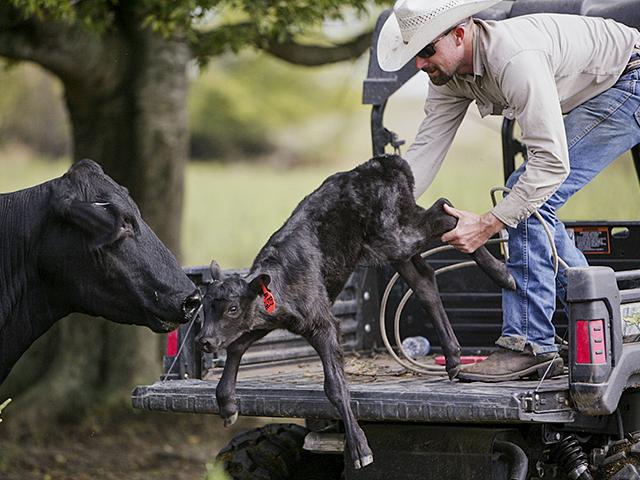Ask the Vet
Preg-Tests Offer Good ROI
READER: What are the advantages and the disadvantages of using a blood test to pregnancy-test cows?
DR. McMILLAN: Years ago, many farmers "bumped a calf" to determine pregnancy. This means they would sharply push in on the cow's abdomen several times and then hold their fist firmly against the abdomen to feel the calf in the uterus as it swung back and forth. This only worked with late-term pregnancies, but it was somewhat useful to know when to dry off a milk cow to let her get ready for the next lactation.
Later, rectal palpation by a veterinarian became the gold standard of pregnancy testing. Experienced veterinarians can accurately determine pregnancy down to as little as 30 days postbreeding. Especially up to four months, the veterinarian can give a fairly accurate estimate of fetal age. In addition, diseases, fetal mummies and injuries that might lead to abortion or difficulty in calving can be identified. This information in real time allows for culling, treatment and sorting decisions while the cow is still in the chute.
Beginning in the mid-1980s, ultrasound became an option. It can often detect pregnancy as early as 28 days, with some techniques reportedly decreasing that to fewer than 20 days. Ultrasound can detect fetal viability, sex and some reproductive or developmental abnormalities. This provides a more precise determination of fetal age, and just like with rectal palpation, results are available immediately.
When properly timed, ultrasound and rectal palpation can distinguish between artificial insemination (AI) and natural service pregnancies.
P[L1] D[0x0] M[300x250] OOP[F] ADUNIT[] T[]
Now, let's talk blood tests. These are probably best called "biochemical tests," because some use blood, and others use milk to identify hormones or proteins unique to pregnancy. These tests are reported 99% accurate and require sample collection. These samples are sent to a central laboratory, and results are available anywhere from a few days to a few weeks. Recently, chuteside tests have been developed for on the farm, with results in 30 minutes or sooner.
With biochemical tests, cattle must be at least 73 to 95 days from calving (depending on the test) to avoid interference from the previous pregnancy. Abortions and early embryonic deaths can result in false positives.
In a year like this one [2023], given the value of cull cows and the cost of feed and hay, I believe it's especially critical to preg-check the cow herd. Convert the freeloaders into bottom-line profits sooner rather than later.
READER: I've read there is a new tick in our area that is dangerous to cattle. What can you tell me about this?
DR. McMILLAN: Haemaphysalis longicornis, also known as the Asian longhorned tick (ALT), is native to eastern Asia. As of 2023, the Centers for Disease Control and Prevention reports it has been identified in Arkansas, Connecticut, Delaware, Georgia, Indiana, Kentucky, Maryland, Massachusetts, Missouri, New Jersey, New York, North Carolina, Ohio, Pennsylvania, Rhode Island, South Carolina, Tennessee, Virginia and West Virginia.
ALT females do not need a mate to lay eggs and reproduce. A single female tick is enough for these parasites to gain a foothold in an area. They are not picky feeders and will infest cattle, horses, deer, pigs, sheep, goats, dogs, cats, bears, foxes, raccoons, rabbits and birds. Animals are often infested with large numbers of these ticks, weakening the host, reducing growth, pulling down body condition and dropping milk production. Infestation can even result in death. These ticks carry diseases including theileriosis and babesiosis, which affect a wide range of domestic animals.
Control of the ALT is no different from that of native ticks. Close, thorough and routine examinations are needed to identify the problem early. ALT ticks are small and easy to miss. When checking, focus on animals that are lethargic, have lost body condition or have patchy hair loss. Inspect new animals prior to introducing them to the herd. If ticks are found, consider submitting them to your state Extension service for identification.
When ticks are found, work with your veterinarian to develop a control program. This may include insecticidal ear tags, back rubs, dust bags, sprays, pour-on products or a combination. All animals must be treated. Keep pastures mowed, clear up brush around pasture edges, and keep cattle out of wooded areas.
The risk to humans from the ALT is still being researched. There is little evidence at this time that the ALT carries diseases that can infect humans.
**
-- Please contact your veterinarian with questions pertaining to the health of your herd. Every operation is unique, and the information in this column does not pertain to all situations. This is not intended as medical advice but is purely for informational purposes.
-- Write Dr. Ken McMillan at Ask The Vet, 2204 Lakeshore Dr., Suite 415, Birmingham, AL 35209, or email vet@progressivefarmer.com
[PF_1023]
(c) Copyright 2023 DTN, LLC. All rights reserved.




